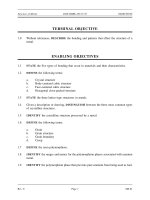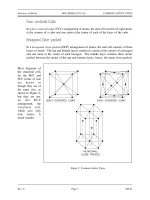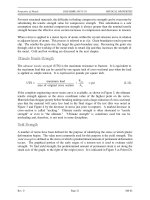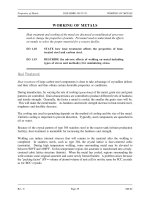Material Science_ Vol 2 of 2 - US DOE (1993) Episode 7 pptx
Bạn đang xem bản rút gọn của tài liệu. Xem và tải ngay bản đầy đủ của tài liệu tại đây (59.95 KB, 10 trang )
DOE-HDBK-1017/2-93
Plant Materials PROPERTIES CONSIDERED WHEN SELECTING MATERIALS
PROPERTIES CONSIDERED
WHEN SELECTING MATERIALS
There are many different kinds of materials used in the construction of a nuclear
facility. Once constructed, these materials are subjected to environments and
operating conditions that may lead to material problems. This chapter discusses
considerations for selection and application of plant materials.
EO 1.1 DEFINE the following terms:
a. Machinability
b. Formability
c. Stability
d. Fabricability
EO 1.2 IDENTIFY the importance of a material property and its
application in a reactor plant.
Overview
During the selection and application of materials used for construction of a nuclear facility, many
different material properties and factors must be considered depending upon the requirements for
each specific application. Generally, these consist of both non-fuel reactor materials, used for
structural and component construction, and fuel materials. This chapter discusses some of the
considerations used in the selection process for plant materials including material properties, fuel,
fuel cladding, reflector material, control materials, and shielding materials.
Material Properties
The following properties are considered when selecting materials that are to be used in the
construction of nuclear facilities.
Machinability
Components may be formed by removing metal "chips" by mechanical deformation. This
process is referred to as machining.
Machinability describes how a metal reacts to
mechanical deformation by removing chips, with respect to the amount of metal
effectively removed and the surface finish attainable. The mechanical properties of the
metal will be the factors that influence the machinability of a metal.
Many components used in nuclear reactor construction use machined parts that require
very close tolerances and very smooth surfaces. Thus, machinability becomes an
important consideration when choosing materials for manufacturing these parts.
Rev. 0 Page 1 MS-05
DOE-HDBK-1017/2-93
PROPERTIES CONSIDERED WHEN SELECTING MATERIALS Plant Materials
Formability
Components may be formed by processes such as rolling or bending, which may cause
some parts of the metal to expand more than others.
Formability of a material is its
ability to withstand peripheral expansion without failure or the capacity of the material
to be to manufactured into the final required shape. This becomes important in selecting
materials that have to be made into specific shapes by such means as rolling or bending
and still retain their required strength.
Ductility
Ductility is the plastic response to tensile force. Plastic response, or plasticity, is
particularly important when a material is to be formed by causing the material to flow
during the manufacture of a component. It also becomes important in components that
are subject to tension and compression, at every temperature between the lowest service
temperature and the highest service temperature. Ductility is essential for steels used in
construction of reactor pressure vessels. Ductility is required because the vessel is
subjected to pressure and temperature stresses that must be carefully controlled to
preclude brittle fracture. Brittle fracture is discussed in more detail in Module 4, Brittle
Fracture.
Stability
Stability of a material refers to its mechanical and chemical inertness under the conditions to
which it will be subjected. Nuclear plants have a variety of environments to which materials
are subjected. Some of these environments, such as high temperatures, high acid, high
radiation, and high pressure, can be considered extreme and harsh; therefore, the stability of
the materials selected for service in these areas is a major consideration.
Corrosion mechanisms can become very damaging if not controlled. They are identified
in Module 2, Properties of Metals. High corrosion resistance is desirable in reactor
systems because low corrosion resistance leads to increased production of corrosion
products that may be transported through the core. These products become irradiated and
contaminate the entire system. This contamination contributes to high radiation levels after
shutdown. For these reasons, corrosion resistant materials are specially chosen for use in
the primary and secondary coolant systems.
Availability
The availability of a material used in the construction of nuclear plants refers to the ease
with which a material can be obtained and its cost.
MS-05 Page 2 Rev. 0
DOE-HDBK-1017/2-93
Plant Materials PROPERTIES CONSIDERED WHEN SELECTING MATERIALS
Fabricability
Fabricability is a measure of the ease with which a material can be worked and made into
desirable shapes and forms. Many components of a nuclear reactor have very complicated
shapes and forms and require very close tolerances. Therefore, fabricability is an
important consideration in the manufacturing of these components.
Heat Transfer
Good heat transfer properties are desirable from the fuel boundary to the coolant in order
that the heat produced will be efficiently transferred.
For a constant amount of heat transfer, a degraded heat transfer characteristic requires
higher fuel temperature, which is not desirable. Therefore, desirable heat transfer
properties in the selection of reactor materials, especially those used as core cladding and
heat exchanger tubes, are a major consideration.
Cost
Capital costs for building a typical nuclear facility can be millions of dollars. A major
portion of the cost is for plant material; therefore, cost is an important factor in the
selection of plant materials.
Mechanical Strength
Preventing release of radioactive fission products is a major concern in the design,
construction, and operation of a nuclear plant. Therefore, mechanical strength plays an
important role in selecting reactor materials. High mechanical strength is desirable because
of its possible degradation due to radiation damage and the need to contain the radioactive
liquids and fuel.
Rev. 0 Page 3 MS-05
DOE-HDBK-1017/2-93
PROPERTIES CONSIDERED WHEN SELECTING MATERIALS Plant Materials
Summary
The important information in this chapter is summarized below.
Material Properties Considered for Selection Summary
Machinability is the ability of a metal to react to mechanical deformation by
removing chips, with respect to the amount of metal effectively removed and the
surface finish attainable. This property is important when selecting parts that
require very close tolerances and very smooth surfaces.
Formability of a material is its ability to withstand peripheral expansion without
failure or the capacity of the material to be manufactured into the final required
shape. This property is important when selecting materials that have to be made
into specific shapes by such means as rolling or bending and still retain their
required strength.
Stability of a material refers to its mechanical and chemical inertness under the
conditions to which it will be subjected. This property is important when selecting
materials environments such as high temperature, high acid, high radiation, and
high pressure environments.
Fabricability is a measure of the ease with which a material can be worked and
made into desirable shapes and forms. This property is important when materials
are required to have very complicated shapes or forms and require very close
tolerances.
Ductility is essential for materials that are subject to tensile and compressive
stresses. Ductility is important in the construction of reactor vessels.
Availability is the ease with which material can be obtained and its cost.
Good heat transfer properties are desirable for the boundary between the fuel and
the coolant. These properties are desirable for heat exchanger tubes, fuel cladding,
etc.
Cost is an important factor in selecting plant materials.
MS-05 Page 4 Rev. 0
Plant Materials DOE-HDBK-1017/2-93 FUEL MATERIALS
FUEL MATERIALS
Nuclear plants require radioactive material to operate. Certain metals that are
radioactive can be used to produce and sustain the nuclear reaction. This chapter
discusses the materials used in the various nuclear applications. The student
should refer to the Nuclear Physics and Reactor Theory Fundamentals Handbook
prior to continuing to better understand the material in this chapter.
EO 1.3 LIST the four radioactive materials that fission by thermal neutrons
and are used as reactor fuels.
EO 1.4 STATE the four considerations in selecting fuel material and the
desired effect on the nuclear properties of the selected fuel
material.
Overview of Material Types
The reactor core is the heart of any nuclear reactor and consists of fuel elements made of a
suitable fissile material. There are presently four radioactive materials that are suitable for fission
by thermal neutrons. They are uranium-233 (
233
U), uranium-235 (
235
U), plutonium-239 (
239
Pu),
and plutonium-241 (
241
Pu). The isotopes uranium-238 (
238
U) and thorium-232 (
232
Th) are
fissionable by fast neutrons. The following text discusses plutonium, uranium, and thorium as
used for nuclear fuel.
Plutonium
Plutonium is an artificial element produced by the transmutation of
238
U. It does exist in small
amounts (5 parts per trillion) in uranium ore, but this concentration is not high enough to be
mined commercially.
Plutonium is produced by the conversion of
238
U into
239
Pu according to the following reaction.
23
9
8
2
U +
1
o
n →
23
9
9
2
U
23
9
9
3
Np
23
9
9
4
Pu
β
→
β
→
This reaction occurs in reactors designed specifically to produce fissionable fuel. These reactors
are frequently called breeder reactors because they produce more fissionable fuel than is used in
the reaction. Plutonium is also produced in thermal
235
U reactors that contain
238
U. Plutonium
can be obtained through the processing of spent fuel elements. To be useful as a fuel, plutonium
must be alloyed to be in a stable phase as a metal or a ceramic.
Rev. 0 Page 5 MS-05
FUEL MATERIALS DOE-HDBK-1017/2-93 Plant Materials
Plutonium dioxide (PuO
2
) is the most common form used as a reactor fuel. PuO
2
is not used
alone as a reactor fuel; it is mixed with uranium dioxide. This mixture ranges from 20%
plutonium dioxide for fast reactor fuel to 3% to 5% for thermal reactors.
Plutonium-239 can serve as the fissile material in both thermal and fast reactors. In thermal
reactors, the plutonium-239 produced from uranium-238 can provide a partial replacement for
uranium-235. The use of plutonium-239 in fast reactors is much more economical, because
breeding takes place, which results in the production of more plutonium-239 than is consumed
by fission.
Uranium
The basic nuclear reactor fuel materials used today are the elements uranium and thorium.
Uranium has played the major role for reasons of both availability and usability. It can be used
in the form of pure metal, as a constituent of an alloy, or as an oxide, carbide, or other suitable
compound. Although metallic uranium was used as a fuel in early reactors, its poor mechanical
properties and great susceptibility to radiation damage excludes its use for commercial power
reactors today. The source material for uranium is uranium ore, which after mining is
concentrated in a "mill" and shipped as an impure form of the oxide U
3
O
8
(yellow cake). The
material is then shipped to a materials plant where it is converted to uranium dioxide (UO
2
), a
ceramic, which is the most common fuel material used in commercial power reactors. The UO
2
is formed into pellets and clad with zircaloy (water-cooled reactors) or stainless steel (fast
sodium-cooled reactors) to form fuel elements. The cladding protects the fuel from attack by the
coolant, prevents the escape of fission products, and provides geometrical integrity.
Oxide fuels have demonstrated very satisfactory high-temperature, dimensional, and radiation
stability and chemical compatibility with cladding metals and coolant in light-water reactor
service. Under the much more severe conditions in a fast reactor, however, even inert UO
2
begins to respond to its environment in a manner that is often detrimental to fuel performance.
Uranium dioxide is almost exclusively used in light-water-moderated reactors (LWR). Mixed
oxides of uranium and plutonium are used in liquid-metal fast breeder reactors (LMFBR).
The major disadvantages of oxide fuels that have prompted the investigation of other fuel
materials are their low uranium density and low thermal conductivity that decreases with
increasing temperatures. The low density of uranium atoms in UO
2
requires a larger core for a
given amount of fissile species than if a fuel of higher uranium density were used. The increase
in reactor size with no increase in power raises the capital cost of the reactor. Poor thermal
conductivity means that the centerline temperature of the fuel and the temperature difference
between the center and the surface of the fuel rod must be very large for sufficient fission heat
be extracted from a unit of fuel to make electric power production economical. On the other
hand, central fuel temperatures close to the melting point have a beneficial fission product
scouring effect on the fuel.
MS-05 Page 6 Rev. 0
Plant Materials DOE-HDBK-1017/2-93 FUEL MATERIALS
Thorium
Natural thorium consists of one isotope,
232
Th, with only trace quantities of other much more
radioactive thorium isotopes. The only ore mineral of thorium, that is found in useful amounts
is monazite. Monazite-bearing sands provide most commercial supplies. The extraction and
purification of thorium is carried out in much the same manner as for uranium. Thorium dioxide
(ThO
2
) is used as the fuel of some reactors. Thorium dioxide can be prepared by heating thorium
metal or a wide variety of other thorium compounds in air. It occurs typically as a fine white
powder and is extremely refractory (hard to melt or work) and resistant to chemical attack.
The sole reason for using thorium in nuclear reactors is the fact that thorium (
232
Th) is not fissile,
but can be converted to uranium-233 (fissile) via neutron capture. Uranium-233 is an isotope of
uranium that does not occur in nature. When a thermal neutron is absorbed by this isotope, the
number of neutrons produced is sufficiently larger than two, which permits breeding in a thermal
nuclear reactor. No other fuel can be used for thermal breeding applications. It has the superior
nuclear properties of the thorium fuel cycle when applied in thermal reactors that motivated the
development of thorium-based fuels. The development of the uranium fuel cycle preceded that
of thorium because of the natural occurrence of a fissile isotope in natural uranium, uranium-235,
which was capable of sustaining a nuclear chain reaction. Once the utilization of uranium
dioxide nuclear fuels had been established, development of the compound thorium dioxide
logically followed.
As stated above, thorium dioxide is known to be one of the most refractory and chemically
nonreactive solid substances available. This material has many advantages over uranium dioxide.
Its melting point is higher; it is among the highest measured. It is not subject to oxidation
beyond stoichiometric (elements entering into and resulting from combination) ThO
2
. At
comparable temperatures over most of the expected operating range its thermal conductivity is
higher than that of UO
2
. One disadvantage is that the thorium cycle produces more fission gas
per fission, although experience has shown that thorium dioxide is superior to uranium dioxide
in retaining these gases. Another disadvantage is the cost of recycling thoria-base fuels, or the
"spiking" of initial-load fuels with
233
U. It is more difficult because
233
U always contains
232
U
as a contaminant.
232
U alpha decays to
228
Th with a 1.9 year half-life. The decay chain of
228
Th
produces strong gamma and alpha emitters. All handling of such material must be done under
remote conditions with containment.
Investigation and utilization of thorium dioxide and thorium dioxide-uranium dioxide
(thoria-urania) solid solutions as nuclear fuel materials have been conducted at the Shipping port
Light Water Breeder Reactor (LWBR). After a history of successful operation, the reactor was
shut down on October 1, 1982. Other reactor experience with ThO
2
and ThO
2
-UO
2
fuels have
been conducted at the Elk River (Minnesota) Reactor, the Indian Point (N.Y.) No. 1 Reactor, and
the HTGR (High-temperature Gas-cooled Reactor) at Peach Bottom, Pennsylvania, and at Fort
St. Vrain, a commercial HTGR in Colorado.
Rev. 0 Page 7 MS-05
FUEL MATERIALS DOE-HDBK-1017/2-93 Plant Materials
As noted above, interest in thorium as a contributor to the world's useful energy supply is based
on its transmutability into the fissile isotope
233
U. The ease with which this property can be
utilized depends on the impact of the nuclear characteristics of thorium on the various reactor
systems in which it might be placed and also on the ability to fabricate thorium into suitable fuel
elements and, after irradiation, to separate chemically the resultant uranium. The nuclear
characteristics of thorium are briefly discussed below by comparing them with
238
U as a point of
reference.
First, a higher fissile material loading requirement exists for initial criticality for a given reactor
system and fissile fuel when thorium is used than is the case for an otherwise comparable system
using
238
U.
Second, on the basis of nuclear performance, the interval between refueling for comparable
thermal reactor systems can be longer when thorium is the fertile fuel. However, for a given
reactor system, fuel element integrity may be the limiting factor in the depletion levels that can
be achieved.
Third,
233
Pa (protactinium), which occurs in the transmutation chain for the conversion of thorium
to
233
U, acts as a power history dependent neutron poison in a thorium-fueled nuclear reactor.
There is no isotope with comparable properties present in a
238
U fuel system.
Fourth, for comparable reactor systems, the one using a thorium-base fuel will have a larger
negative feedback on neutron multiplication with increased fuel temperature (Doppler coefficient)
than will a
238
U-fueled reactor.
Fifth, for comparable reactor configurations, a
232
Th/
233
U fuel system will have a greater stability
relative to xenon-induced power oscillations than will a
238
U/
235
U fuel system. The stability is
also enhanced by the larger Doppler coefficient for the
232
Th/
233
U fuel system.
And sixth, the effective value of
β for
232
Th/
233
U systems is about half that of
235
U-fueled reactors
and about the same as for plutonium-fueled reactors. A small value of
β means that the reactor
is more responsive to reactivity changes.
In conclusion, the nuclear properties of thorium can be a source of vast energy production. As
demonstrated by the Light Water Breeder Reactor Program, this production can be achieved in
nuclear reactors utilizing proven light water reactor technology.
Nuclear Fuel Selection
The nuclear properties of a material must be the first consideration in the selection of a suitable
nuclear fuel. Principle properties are those bearing on neutron economy: absorption and fission
cross sections, the reactions and products that result, neutron production, and the energy released.
These are properties of a specific nuclide, such as
232
Th, and its product during breeding,
233
U.
To assess these properties in the performance of the bulk fuel, the density value, or frequency
of occurrence per unit volume, of the specific nuclide must be used.
MS-05 Page 8 Rev. 0
Plant Materials DOE-HDBK-1017/2-93 FUEL MATERIALS
Once it has been established that the desired nuclear reaction is feasible in a candidate fuel
material, the effect of other material properties on reactor performance must be considered. For
the reactor to perform its function of producing usable energy, the energy must be removed. It
is desirable for thermal conductivity to be as high as possible throughout the temperature range
of operations and working life of the reactor. High thermal conductivity allows high power
density and high specific power without excessive fuel temperature gradients. The selection of
a ceramic fuel represents a compromise. Though it is known that thermal conductivities
comparable to those of metals cannot be expected, chemical and dimensional stability at high
temperature are obtained.
Because the thermal conductivity of a ceramic fuel is not high, it is necessary to generate
relatively high temperatures at the centers of ceramic fuel elements. A high melting point
enables more energy to be extracted, all other things being equal. In all cases, the fuel must
remain well below the melting point in normal operation, but a higher melting point results in
a higher permissible operating temperature.
The dimensional stability of the fuel under conditions of high temperature and high burnup is of
primary importance in determining the usable lifetime. The dimensional stability is compromised
by swelling, which constricts the coolant channels and may lead to rupture of the metal cladding
and escape of highly radioactive fission products into the coolant. The various other factors
leading to the degradation of fuel performance as reactor life proceeds (the exhaustion of
fissionable material, the accumulation of nonfissionable products, the accumulation of radiation
effects on associated nonfuel materials) are all of secondary importance in comparison to
dimensional stability of the fuel elements.
The main cause of fuel element swelling is the accumulation of two fission product atoms for
each atom fissioned. This is aggravated by the fact that some of the fission products are gases.
The ability of a ceramic fuel to retain and accommodate fission gases is therefore of primary
importance in determining core lifetime.
The chemical properties of a fuel are also important considerations. A fuel should be able to
resist the wholesale change in its properties, or the destruction of its mechanical integrity, that
might take place if it is exposed to superheated coolant water through a cladding failure. On the
other hand, certain chemical reactions are desirable.
Other materials such as zirconium and niobium in solid solution may be deliberately incorporated
in the fuel to alter the properties to those needed for the reactor design. Also, it is generally
advantageous for some of the products of the nuclear reaction to remain in solid solution in the
fuel, rather than accumulating as separate phases.
Rev. 0 Page 9 MS-05
FUEL MATERIALS DOE-HDBK-1017/2-93 Plant Materials
The physical properties of the fuel material are primarily of interest in ensuring its integrity
during the manufacturing process. Nevertheless they must be considered in assessments of the
integrity of the core under operating conditions, or the conditions of hypothetical accidents. The
physical and mechanical properties should also permit economical manufacturing. The fuel
material should have a low coefficient of expansion.
It is not possible to fabricate typical refractory ceramics to 100% of their theoretical density.
Therefore, methods of controlling the porosity of the final product must be considered. The role
of this initial porosity as sites for fission gas, as well as its effects on thermal conductivity and
mechanical strength, is a significant factor in the design.
Summary
The important information in this chapter is summarized below.
Fuel Materials Summary
Radioactive materials suitable for fission by thermal neutrons and used as reactor
fuel include:
233
U and
235
U
239
Pu and
241
Pu
Considerations in selecting fuel material are:
High thermal conductivity so that high power can be attained without
excessive fuel temperature gradients
Resistance to radiation damage so that physical properties are not degraded
Chemical stability with respect to coolant in case of cladding failure
Physical and mechanical properties that permit economical fabrication
MS-05 Page 10 Rev. 0









